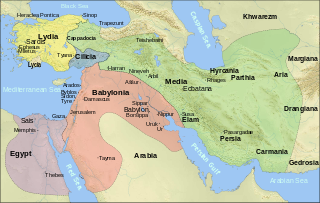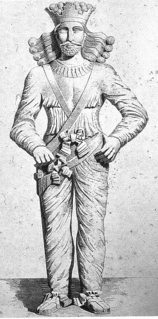Related Research Articles
The Persians are an Iranian ethnic group that make up over half the population of Iran. They share a common cultural system and are native speakers of the Persian language, as well as languages closely related to Persian.

The Medes were an ancient Iranian people who spoke the Median language and who inhabited an area known as Media between western and northern Iran. Around the 11th century BC, they occupied the mountainous region of northwestern Iran and the northeastern and eastern region of Mesopotamia located in the region of Hamadan (Ecbatana). Their consolidation in Iran is believed to have occurred during the 8th century BC. In the 7th century BC, all of western Iran and some other territories were under Median rule, but their precise geographic extent remains unknown.

Shapur I was the second Sasanian King of Kings of Iran. The dating of his reign is disputed, but it is generally agreed that he ruled from 240 to 270, with his father Ardashir I as co-regent until the death of the latter in 242. During his co-regency, he helped his father with the conquest and destruction of the Arab city of Hatra, whose fall was facilitated, according to Islamic tradition, by the actions of his future wife al-Nadirah. Shapur also consolidated and expanded the empire of Ardashir I, waged war against the Roman Empire and seized its cities of Nisibis and Carrhae while he was advancing as far as Roman Syria. Although he was defeated at the Battle of Resaena in 243 by Roman emperor Gordian III, he was the following year able to win the Battle of Misiche and force the new Roman Emperor Philip the Arab to sign a favourable peace treaty that was regarded by the Romans as "a most shameful treaty".

Fars Province, also known as Pars as well as Persis and Persia, is one of the thirty-one provinces of Iran. With an area of 122,400 km², it is located in Iran's southwest, in Region 2, and its administrative center is Shiraz. As of 2011, Fars had a population of 4.6 million people, of whom 67.6% were registered as urban dwellers (urban/suburbs), 32.1% villagers, and 0.3% nomad tribes.

Persis, better known in English as Persia, or Persia proper, is the Fars region, located to the southwest of the modern Iran, now a province. The Persians are thought to have initially migrated either from Central Asia or, more probably, from the north through the Caucasus. They would then have migrated to the current region of Persis in the early 1st millennium BC. The country name Persia was derived directly from the Old Persian Parsa.

Vologases V was King of Kings of the Parthian Empire from 191 to 208. As king of Armenia, he is known as Vologases II. Not much is known about his period of kingship of Armenia, except that he put his son Rev I on the Iberian throne in 189. Vologases succeeded his father Vologases IV as king of the Parthian Empire in 191; it is uncertain if the transition of power was peaceful or if Vologases took the throne in a civil war. When Vologases acceded the Parthian throne, he passed the Armenian throne to his son Khosrov I.

Derafsh Kaviani was the legendary royal standard (vexilloid) of Iran (Persia) used since ancient times until the fall of the Sasanian Empire. The banner was also sometimes called the "Standard of Jamshid", the "Standard of Fereydun" and the "Royal Standard".
Takab or Tekab is a city and capital of Takab County, West Azerbaijan Province, Iran. At the 2006 census, its population was 43,702, in 10,078 families.

The Dahae, also known as the Daae, Dahas or Dahaeans were an Iranian people of ancient Central Asia. A confederation of three tribes – the Parni, Xanthii and Pissuri – the Dahae lived in an area now comprising much of modern Turkmenistan. The area has consequently been known as Dahestan, Dahistan and Dihistan.
Ariobarzanes, was an Achaemenid prince, satrap and a Persian military commander who led an Ambush of the Persian army at the Battle of the Persian Gate against Macedonian King Alexander the Great in the winter of 330 BC.

Media is a region of north-western Iran, best known for having been the political and cultural base of the Medes. During the Achaemenid period, it comprised present-day Azarbaijan, Iranian Kurdistan and western Tabaristan. As a satrapy under Achaemenid rule, it would eventually encompass a wider region, stretching to southern Dagestan in the north. However, after the wars of Alexander the Great, the northern parts were separated due to the Partition of Babylon and became known as Atropatene, while the remaining region became known as Lesser Media.

The Amardians, widely referred to as the Amardi, were an ancient Iranian tribe living along the mountainous region bordering the Caspian Sea to the north, to whom the Iron Age culture at Marlik is attributed. They are said to be related to, or the same tribe as, the Dahae and Sacae. That is to say, they were Scythian. Herodotus mentions a tribe with a similar name as one of the ten to fifteen Persian tribes in Persis. They lived in the valleys in between the Susis and Persis, in what is now southwestern Iran. The southern Mardi are described by Nearchus as one of the four predatory mountain peoples of the southwest, along with the Susians, Uxii, and Elymaeans. Of these four nomadic groups, they were the only tribe linguistically Iranian.

The Iranian peoples or Iranic peoples are a diverse grouping of Indo-European peoples who are identified by their use of the Iranian languages and other cultural similarities.

Ariana was a general geographical term used by some Greek and Roman authors of the ancient period for a district of wide extent between Central Asia and the Indus River, comprising the eastern provinces of the Achaemenid Empire that covered the whole of modern-day Afghanistan, as well as the easternmost part of Iran and up to the Indus River in Pakistan. Ariana is the Latinized form of the Ancient Greek Ἀρ(ε)ιανή Ar(e)ianē, originating from the Old Persian word Ariyanem (Ariana) meaning 'the Land of the Aryans', similar to the use of Āryāvarta.

The Achaemenid Empire, also called the First Persian Empire, was an ancient Iranian empire that was based in Western Asia and founded by Cyrus the Great in 550 BC. It reached its greatest extent under Xerxes I, who conquered most of northern and central ancient Greece. At its greatest territorial extent, the Achaemenid Empire stretched from the Balkans and Eastern Europe in the west to the Indus Valley in the east. The empire was larger than any previous empire in history, spanning a total of 5.5 million square kilometers.

Frataraka is an ancient Persian title, interpreted variously as “leader, governor, forerunner”. It is an epithet or title of a series of rulers in Persis from 3rd to mid 2nd century BC, or alternatively between 295 and 220 BC, at the time of the Seleucid Empire, prior to the Parthian conquest of West Asia and Iran. Studies of frataraka coins are important to historians of this period.
The Maraphii were an Iranian tribe from Persis or Persia, in modern southwestern Iran. This tribe was one of the three main and leading Persian tribes alongside the Maspii and the Pasargadae.

The Kings of Persis, also known as the Darayanids, were a series of Persian kings, who ruled the region of Persis in southwestern Iran, from the 2nd century BCE to 224 CE. They ruled as sub-kings of the Parthian Empire, until they toppled them and established the Sasanian Empire. They effectively formed some Persian dynastic continuity between the Achaemenid Empire and the Sasanian Empire.
The Pasargadae were an Iranian tribe from Persis or Persia Proper, in modern southwestern Iran. This tribe was one of the three main and leading Persian tribes alongside the Maraphii and the Maspii. From the Pasargadae came the Achaemenid royal family. The first capital of the Persian Achaemenid Empire, Pasargadae, was in the land of this tribe and took its name from them.
References
- ↑ "Persis | ancient region, Iran". Encyclopedia Britannica. Retrieved 2017-08-07.